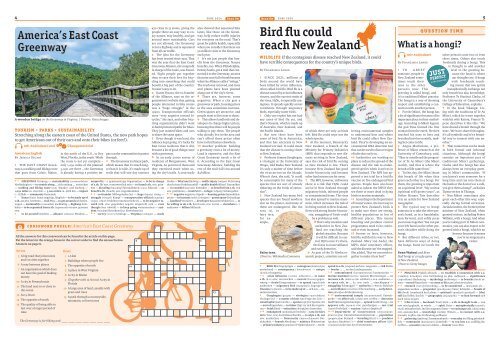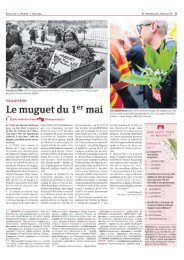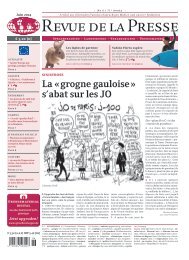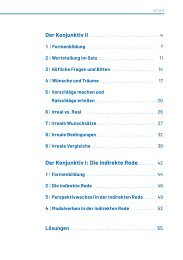Read On Juni 2024, Schnupperseiten
Englisch lernen mit leicht lesbaren Artikeln und ausführlichem Vokabular
Englisch lernen mit leicht lesbaren Artikeln und ausführlichem Vokabular
You also want an ePaper? Increase the reach of your titles
YUMPU automatically turns print PDFs into web optimized ePapers that Google loves.
4 June <strong>2024</strong> June <strong>2024</strong><br />
5<br />
<strong>Read</strong> <strong>On</strong><br />
<strong>Read</strong> <strong>On</strong><br />
America’s East Coast<br />
Greenway<br />
A wooden bridge on the Greenway in Virginia. | Photo: Getty Images<br />
TOURISM • PARKS • SUSTAINABILITY<br />
Stretching along the eastern coast of the United States, the new park hopes<br />
to get Americans out of their cars and onto their bikes (or feet!).<br />
crossword puzzle: America’s East Coast Greenway 1 2<br />
All the answers for this crossword can be found in the article on this page.<br />
Put the letters in the orange boxes in the correct order to find the answer below.<br />
Answers on page 8.<br />
Across<br />
mit Audiodatei und<br />
American English<br />
By Jessica Stuart<br />
1 THE EAST COAST Greenway<br />
is a walking and biking route<br />
that goes from Calais, Maine,<br />
3 A big road that joins towns<br />
and/or cities together<br />
6 A way between places<br />
7 An organisation which does<br />
not have the goal of making<br />
money<br />
10 A city in Pennsylvania<br />
11 The land next to or close to<br />
the ocean<br />
12 See 9 Down<br />
14 The opposite of south<br />
15 The quality of being able to<br />
last over a longer period of<br />
time<br />
Down<br />
Übungsmaterial<br />
0 – 1 GREENWAY Grünzug — sustainability “s´ÆsteIn´"bIl´ti‘<br />
Nachhaltigkeit — to stretch along … sich entlang … erstrecken<br />
— walking and biking route “ru…t‘ Wander- und Radweg —<br />
1,050 miles ca. 1690 km — 3,000 miles ca. 4828 km — impact<br />
“"--‘ Effekt — community Gemeinde<br />
2 linear “"lini´‘ linear angelegt, länglich — to be made up of<br />
s.th. aus etw. bestehen — trail Weg — to get around sich fortbewegen<br />
— sustainably “s´"steIn´bli‘ nachhaltig — highway Autobahn<br />
— to be separated from s.th. “"sep´reItId‘ von etw. getrennt<br />
sein<br />
3 to be around bestehen — alliance “´"laI´ns‘ Bündnis —<br />
1 1.6 km<br />
2 Buildings where people live<br />
4 The opposite of north<br />
5 A place in West Virginia<br />
8 A city in Maine<br />
9 (Together with 12 Across) A city in<br />
Florida<br />
10 A large area of land, usually with<br />
grass and trees<br />
13 A path through a countryside,<br />
mountain, or forest area<br />
The Greenway is for biking and —— —— —— —— —— —— ——<br />
in the north of the U.S., to Key<br />
West, Florida, in the south. While<br />
the route is not yet complete –<br />
only 1,050 miles of the planned<br />
3,000 are there – the Greenway<br />
is already having a positive impact<br />
on the communities it passes<br />
through.<br />
2 The Greenway is a linear park,<br />
which means that it’s much longer<br />
than it is wide. It’s made up of<br />
trails that will one day connect<br />
nonprofit “-"--‘ gemeinnützige Organisation — to be in charge<br />
of s.th. für etw. verantwortlich sein — to found s.th. etw. gründen<br />
— bicycling “"baIsIklIN‘ Fahrradfahren; s.w.u. Fahrrad- — to<br />
benefit s.th. “"benIfIt‘ etw. zugutekommen<br />
4 – 5 co-founder Mitbegründer(in) — huge “hju…dZ‘ riesig —<br />
struggle “"strøg´l‘ Kampf — transportation official “ÆtrœnspO…<br />
"teIS´n; ´"fIS´l‘ Verkehrsverantwortliche(r) — to be negative toward<br />
s.th. etw. gegenüber negativ eingestellt sein — even<br />
though “D´U‘ obwohl — to keep going weitermachen — resident<br />
“"rezId´nt‘ Bewohner(in), Einwohner(in)<br />
6 – 7 survey “"s‰…veI‘ Umfrage — Virginia “v´"dZInj´‘ — study<br />
6<br />
10<br />
3<br />
4 5<br />
8 9<br />
7<br />
11<br />
12 13<br />
15<br />
450 cities in 15 states, giving the<br />
people there an easy way to enjoy<br />
nature, stay healthy, and get<br />
around more sustainably. Cars<br />
are not allowed; the Greenway<br />
is not a highway and is separated<br />
from all car traffic.<br />
3 The idea for the Greenway<br />
has been around since 1991. That<br />
was the year that the East Coast<br />
Greenway Alliance, the nonprofit<br />
in charge of the route, was founded.<br />
Eight people got together<br />
then to turn their love for bicycling<br />
into something that could<br />
benefit a big part of the country.<br />
It wasn’t easy to do.<br />
4 Karen Votava, the co-founder<br />
of the Alliance, says on the organization’s<br />
website that getting<br />
people interested in bike routes<br />
was a “huge struggle” in the<br />
1990s. Transportation officials<br />
were “very negative toward bicycles,”<br />
she says, and other bicycling<br />
organizations didn’t want<br />
to build protected paths for bikes.<br />
They just wanted bikes and cars<br />
to share the same space.<br />
5 Even though it was hard, the<br />
Alliance kept going. It’s lucky for<br />
East Coast residents that it did,<br />
because a lot of good things come<br />
with a greenway.<br />
6 In an early 2000s survey of<br />
residents of Morgantown, West<br />
Virginia, 60 percent of them said<br />
they exercised more when using<br />
the city’s trails. A 2019 study<br />
also showed that separated bike<br />
lanes, like those on the Greenway,<br />
help reduce traffic injuries<br />
for everyone on the road. That’s<br />
great for public health, especially<br />
when you consider that there are<br />
50 million visits to the Greenway<br />
each year.<br />
7 It’s not just people that benefit<br />
from the Greenway. Nature<br />
benefits, too. When Philadelphia,<br />
Pennsylvania, got a trail that connected<br />
it to the Greenway, an area<br />
that was once full of trash became<br />
what the Alliance calls a “refuge.”<br />
The trash was removed, and trees<br />
and plants have been planted<br />
along one of the city’s rivers.<br />
8 There are, however, some<br />
negatives. When a city gets a<br />
greenway or park, housing prices<br />
in the area sometimes increase.<br />
Green spaces are attractive, and<br />
people want to live next to them.<br />
9 This allows landlords and developers<br />
to charge higher prices,<br />
knowing that there will be people<br />
willing to pay them. The people<br />
who already live in the area and<br />
can’t afford those prices often<br />
have to find homes elsewhere.<br />
10 Another problem: building<br />
a greenway costs a lot of money.<br />
Land is expensive, and the East<br />
Coast Greenway needs a lot of<br />
it. According to the East Coast<br />
Greenway Alliance, building the<br />
rest of the trail will cost around<br />
$4 billion.<br />
Studie — bike lane Radweg — traffic injury “"IndZ´ri‘ Verletzung<br />
durch einen Verkehrsunfall — public health öffentl. Gesundheit<br />
— to consider “k´n"sId´‘ bedenken — to benefit from s.th. von<br />
etw. profitieren — trash Müll — refuge “"refju…dZ‘ Schutzgebiet<br />
8 – 10 negative negativer Aspekt — housing prices Immobilienpreise<br />
— to increase “In"kri…s‘ steigen — green space Grünanlage<br />
— landlord Vermieter — developer Bauunternehmer(in) — to<br />
be willing to do s.th. bereit sein, etw. zu tun — elsewhere “-"-‘<br />
anderswo — billion Milliarde<br />
14<br />
Bird flu could<br />
reach New Zealand<br />
WILDLIFE If the contagious disease reached New Zealand, it could<br />
have terrible consequences for the country’s unique birds.<br />
By Franziska Lange<br />
1 SINCE 2021,millions of<br />
birds around the world have<br />
been killed by avian influenza,<br />
often called bird flu. Bird flu is a<br />
disease caused by avian influenza<br />
viruses, and the current strain of<br />
the virus, H5N1, is especially contagious.<br />
It spreads quickly across<br />
continents through migratory<br />
birds, especially water birds.<br />
2 <strong>On</strong>ly one region has not had<br />
any cases of bird flu yet, and<br />
that’s Oceania, which is made up<br />
of Australia, New Zealand, and<br />
the Pacific Islands.<br />
3 But now there have been<br />
cases of bird flu in Antarctica,<br />
and that has scientists in New<br />
Zealand worried. It could mean<br />
that the disease is coming closer<br />
to New Zealand.<br />
4 Professor Jemma Geoghegan,<br />
a virologist at the University of<br />
Otago, told Radio New Zealand<br />
it’s only a matter of time before<br />
the virus arrives on the islands.<br />
When it does, she said, “it could<br />
be catastrophic for many of the<br />
species that are sort of already<br />
tinkering on the brink of extinction”.<br />
5 New Zealand has many bird<br />
species that are found nowhere<br />
else on the planet, and many of<br />
them are endangered, like the<br />
tara iti, or<br />
fairy tern,<br />
for example,<br />
Fairy tern.<br />
| Photo: Wikimedia Commons<br />
Photo: Getty Images<br />
|<br />
of which there are only 40 birds<br />
left. Bird flu could wipe out the<br />
whole species.<br />
6 At the moment, Bio security<br />
New Zealand, a branch of the<br />
Ministry for Primary Industries<br />
(MPI) that responds to new diseases<br />
arriving in New Zealand,<br />
says the risk of bird flu coming<br />
to New Zealand is low. That’s<br />
because New Zealand has good<br />
border biosecurity and because<br />
other land masses are far away.<br />
7 The MPI, however, still warns<br />
there is a risk that H5N1 could<br />
arrive in New Zealand through<br />
migratory birds, infected people<br />
or contaminated items. The virus<br />
has also spread to marine mammals,<br />
which increases the risk of<br />
its being carried to New Zealand.<br />
Even with strong border biosecurity,<br />
smuggling of birds could<br />
be a problem as well.<br />
8 That’s why scientists and<br />
authorities in New Zealand<br />
are watching the<br />
global situation. Because<br />
it will be difficult to control<br />
H5N1 once it’s there,<br />
the focus is on surveillance<br />
and early detection.<br />
9 As part of the Te Niwha research<br />
project, scientists are collecting<br />
environmental samples<br />
to understand how and where<br />
bird flu could affect New Zealand.<br />
They’re developing an environmental<br />
DNA detection tool<br />
that can be used to discover signs<br />
of infection early on.<br />
10 Authorities are working on<br />
plans to reduce the spread of the<br />
disease and the risk to endangered<br />
species when it arrives in<br />
New Zealand. The MPI has approved<br />
a test trial for a bird flu<br />
vaccine on five endangered bird<br />
species. People have also been<br />
asked to inform the MPI if they<br />
see three or more dead or dying<br />
birds or marine mammals.<br />
11 According to the Department<br />
of Conservation, the best way to<br />
protect New Zealand’s birds is<br />
to make sure there are strong,<br />
healthy populations in lots of<br />
different places. This means<br />
breeding and predator control<br />
programmes need to be continued<br />
or even increased.<br />
12 Sooner or later, however,<br />
bird flu will find its way to New<br />
Zealand. Mary van Andel, the<br />
MPI’s chief veterinary officer,<br />
said the disease can’t be stopped.<br />
She added, “But we can work together<br />
to make it less bad.”<br />
0 BIRD FLU Vogelgrippe — contagious “k´n"teIdZ´s‘<br />
ansteckend — consequence “"kÅnsIkw´ns‘ — unique<br />
“ju…"ni…k‘ einzigartig<br />
1 – 3 avian influenza “"eIvi´n; ÆInflu"enz´‘ — to cause<br />
s.th. “kO…z‘ etw. verursachen — current “"kør´nt‘ gegenwärtig<br />
— strain Erregerstamm — to spread “spred‘ sich<br />
ausbreiten — migratory bird “"maIgr´t´ri‘ Zugvogel —<br />
Oceania “´USi"A…ni´‘ — to be made up of ... sich aus … zusammensetzen<br />
4 Geoghegan “"geIg´n‘ — virologist “vaI´"rÅl´dZIst‘<br />
Virologe(-in) — a matter of time eine Frage der Zeit —<br />
catastrophic “Ækœt´"strÅfIk‘ — species “"spi…Si…z‘ Spezies; Art<br />
— sort of irgendwie — to tinker (fig) vor sich hin vegetieren<br />
— brink Rand — extinction “Ik"stINkS´n‘ Aussterben<br />
5 – 6 endangered “In"deIndZ´d‘ bedroht — tara iti/fairy<br />
tern “"fe´ri Æt‰…n‘ Australseeschwalbe — to wipe s.th. out<br />
etw. auslöschen — biosecurity “ÆbaI´UsI"kjU´r´ti‘ Biosicherheit<br />
— branch Abteilung — ministry Ministerium<br />
— primary industry “"praIm´ri‘ Primärindustrie — to respond<br />
to s.th. “rI"spÅnd‘ auf etw. reagieren — risk Risiko<br />
— border … … an den Landesgrenzen<br />
7 – 8 contaminated “k´n"tœmIneItId‘ kontaminiert —<br />
marine mammal “m´"ri…n; "mœm´l‘ Meeressäuger — to<br />
increase s.th. “in"kri…s‘ etw. erhöhen; s.w.u. ausbauen —<br />
to carry s.th. to … h.: etw. nach … einschleppen —<br />
smuggling Schmuggel — authority “O…"TÅr´ti‘ Behörde<br />
— surveillance “s´"veIl´ns‘ Überwachung — early detection<br />
“dI"tekS´n‘ Früherkennung<br />
9 – 10 environmental sample “InÆvaIr´"ment´l‘ Umweltprobe<br />
— to affect s.th. “´"fekt‘ etw. treffen — detection<br />
tool Erkennungstechnologie — spread Ausbreitung — to<br />
approve s.th. “´"pru…v‘ etw. genehmigen — test trial<br />
“"traI´l‘ Probelauf — vaccine “"vœksIn‘ Impfstoff<br />
11 – 12 Department of Conservation “dI"pA…tm´nt;<br />
ÆkÅns´"veIS´n‘ Umweltschutzministerium — population<br />
“ÆpÅpj´"leIS´n‘ Bestand — breeding Brut(-) — predator<br />
“"pred´t´‘ Raubtier(-) — chief veterinary officer “tSi…f;<br />
"vet´rIn´ri‘ Leiter(in) des Veterinäramts<br />
question time<br />
What is a hongi?<br />
mit Audiodatei<br />
By Franziska Lange<br />
1 TO GREET<br />
someone, people in<br />
New Zealand sometimes<br />
touch their<br />
nose to the other<br />
person’s nose. This<br />
greeting is called hongi, and<br />
it’s a traditional Māori practice.<br />
The hongi is a way of showing<br />
respect and establishing a connection<br />
with another person.<br />
2 For the Māori, the hongi has<br />
a lot of significance because of its<br />
important place in their mythology.<br />
According to Māori legend,<br />
the god Tāne formed the first<br />
woman from the earth. He then<br />
touched his nose to hers and<br />
breathed into her nostrils, making<br />
her come to life.<br />
3 Angus Macfarlane, a professor<br />
of Māori research at the<br />
University of Canterbury, said,<br />
“Tāne is considered the progenitor<br />
of Te Ao Māori (the Māori<br />
world), and that is where the<br />
breath of life came from.”<br />
4 To this day, the Māori share<br />
this breath of life when they<br />
greet each other in a hongi. For<br />
them, the greeting is important<br />
on a spiritual level: “My wairua<br />
(spiritual self) greets yours”, as<br />
Father Henare Tate describes<br />
it in an article for New Zealand<br />
Geographic.<br />
5 The typical way to hongi<br />
someone is to take the other person’s<br />
hand, as in a handshake,<br />
lean forward, and softly press<br />
your noses together. You can put<br />
your left hand on the other person’s<br />
shoulder while doing the<br />
hongi.<br />
6 But different tribes, or iwi,<br />
have different ways of doing<br />
the hongi. Some iwi touch the<br />
Sean Wainui and Bryn<br />
Hall hongi at a rugby game<br />
in New Zealand.<br />
| Photo: Getty Images<br />
other person’s nose two or even<br />
three times. Others also touch<br />
foreheads during a hongi. This<br />
is thought to add another<br />
level to the greeting because<br />
the head is where<br />
our thoughts are. A hongi<br />
with foreheads touching<br />
means that two spirits<br />
metaphorically exchange not<br />
only breath but also knowledge,<br />
Professor Te Hurinui Clarke, of<br />
the University of Canterbury’s<br />
College of Education, explains.<br />
7 In the book Tikanga: Living<br />
with the traditions of Te Ao<br />
Māori, which he wrote together<br />
with his wife Kaiora, Francis Tipene<br />
describes it like this: “We<br />
have shared a breath through the<br />
nose. We have shared thoughts.<br />
It’s all symbolic and it’s a beautiful<br />
way to connect with one another.”<br />
8 That connection can be made<br />
in both formal and informal<br />
situations. Although the hongi<br />
remains an important part of<br />
traditional Māori gatherings,<br />
Clarke said the hongi has also<br />
always been an everyday greeting<br />
in Māori communities. “If<br />
you haven’t seen someone for a<br />
long time and run into them at<br />
the bank or the doctor’s or a café,<br />
you give them a hongi”, as Kaiora<br />
Tipene writes in Tikanga.<br />
9 Non-Māori sometimes also<br />
greet each other this way, especially<br />
during formal occasions.<br />
Jacinda Ardern, the former prime<br />
minister of New Zealand, often<br />
greeted visitors, including Prince<br />
William, with a hongi. And when<br />
you’re taking part in Māori ceremonies,<br />
you can also expect to be<br />
greeted with a hongi, which is an<br />
honour because it means<br />
you’re no longer just a<br />
visitor.<br />
0 – 2 PRACTICE Praktik; Brauch — to establish a connection with s.o.<br />
“I"stœblIS; k´"nekS´n‘ eine Verbindung zu jdm. aufbauen — significance<br />
“ÆsIg"nIfIk´ns‘ Bedeutung — mythology “mI"TÅl´dZi‘ — to breathe “bri…D‘ atmen<br />
— nostril Nasenloch — to come to life zum Leben erwachen<br />
3 – 5 research “rI"s‰…tS‘ Forschung — to be considered … “k´n"sId´d‘ als …<br />
angesehen werden — progenitor “pr´U"dZenIt´‘ Vater; Schöpfer — breath of<br />
life “breT‘ Atemhauch des Lebens — spiritual “"spIrItSu´l‘ spirituell — (the)<br />
self das Selbst; das Ich — geographic “ÆdZi´"grœfIk‘ — to lean forward sich<br />
nach vorne neigen<br />
6 – 7 tribe Stamm — forehead “"fÅrId‘ Stirn — s.th. is thought to do … von<br />
etw. wird geglaubt, es würde … — spirit Geist — metaphorically “Æmet´"fO…<br />
rIk´li‘ metaphorisch, im übertragenen Sinne — to exchange s.th. “Iks"tSeIndZ‘<br />
etw. austauschen — knowledge “"nÅlIdZ‘ Wissen — to connect with s.o.<br />
“k´"nekt‘ zu jdm. eine Verbindung aufbauen<br />
8 – 9 gathering “"gœD´rIN‘ Zusammenkunft — everyday im Alltag gebräuchlich<br />
— community “k´m"ju…n´ti‘ Gemeinde — to run into s.o. zufällig jdn.<br />
treffen — occasion “´"keIZ´n‘ Anlass — honour “"Ån´‘ Ehre
















